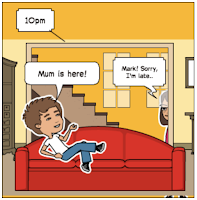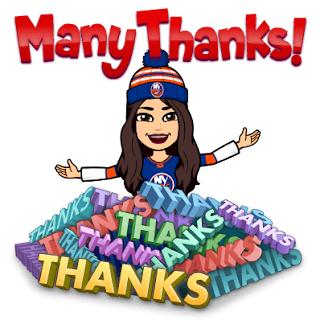Hi everyone!!
In this post I am going to show you my final project (artifact). Until the last moment I did not know how making my artifact, at first I thought about recording a video in which I explained a summary of the subject and its activities, then I thought to make an interactive image with Genial.ly but finally I decided to use a new tool known as "VideoScribe" was a bit risky because I have never used it and I have had to watch some explicit videos to learn how to use it.
VideoScribe is a tool that offers many possibilities in the edition of objects and animation, the only problem is that you can not add videos and if you want to download your designs you have to sign up and pay at least a month, if not you make the video has as background the logo of VideoScribe. I have also used iMovie to record and add the audio of my explanation and the music is a clip that is included in the tool itself.
Next, you can see my artifact (I hope you like it):
Next, you can see my artifact (I hope you like it):
Then, I will show a short summary about each of the activities we have done during the subject. There have been 17 activities distributed in 8 blocks (except for the first activity) which I mention one by one throughout my artifact but if you want to see them individually, I leave the links of each of them in the name of the activity.
Activity 1 - Welcome Forum
Activity 1 - Welcome Forum
Block 1 - First things first.
- Creating a blog. Create my blog through Blogger
- Create your own avatar. To create my avatar I used Bitmoji and for the welcome video on the blog I used RawShort and iMovie.
Block 2 - Respect for authorship.
- Creative Commons. I have never used this resource before, but I will always take it into account now.
- The attribution of the image for a CLIL class. I carried out the activity directed to the learning of the respiratory system through an image of OpenSax College.
Block 3 - Content Curation and disemmination
- Content Curation. In the CLIL material search for my lesson I was driving Pinterest, Symbaloo and List.ly. Finally, I decided to choose the picture because I had already used it before.
- Twitter. Through this well-known social network among all those who went to class that day we created a Tiny Story (#tinystory_URJC), it was a very fun activity because you barely had time to answer a tweet when several colleagues had already answered before. We had a great time that afternoon.
Block 4 - Think, design and present.
- Educational Slideshows. In this activity I used an incredible tool as it is Genial.ly, I had met her a couple of weeks before and the truth was that I liked it worse but I did not know all the possibilities it offers. It is a super good resource, although it is somewhat complex.
Block 5 - Visualize and share.
- Comics. The activity consisted in creating a comic in which feelings will be shown. For this activity I discovered Pixton which is a simple tool that provides many resources to make an original comic. At first I misunderstood the activity and my first comic did not meet the criteria so I had to create a second one (sincerely, I liked the latter more). The only problem I saw so much in this as in other applications to create comic is that after the time free trial if you do not pay a pack you can not do anything with the comic.
- Mindmaps. Some time ago I had made mental maps with the iPad but never before had done with the computer and the truth is very different. For this activity I used Coogle, a tool that at first seems complicated, but when you take 5-10 minutes managing it, you verify that it is simple and intuitive.
- Infographics. Although I had seen this resource many times, I did not know what they were called or how to do them. In order to do my infographic on the adjectives I tried Easel.ly and Piktochart but I could not learn to use them and I remembered that with Genial.ly there was also that option so I was encouraged to try it with this last tool and finally I could do my infographic how I wanted.
Block 6 - Podcast it!
- Podcasting. For this activity, I had to first write a script in Google Docs, then I recorded my podcast through Soundcloud and finally create three music lists, one for each moment of the class, (with Souncloud too). It has been one of the activities that has cost me the most because I had to record the video 4 times because the first three times a day was going to keep it erased but it was a good experience.
Block 7 - Flip it!
Group Work
- Storyboard a video project. The task was to create a script about the video that we would record the following week, so we had to be very clear about what we wanted to record, the materials we would need and, most importantly, what objective we had with the video. Throughout this activity we use Pixton (comic), Google Doc (script) and Twitter (share photos).
- Record your video clip. The activity was done in INTEF where we had a chroma to record our video which was later edited with iMovie and GarageBand.
Individual Work
- #twima8. The world is my audience. The activity consisted of recording the first personal experience as a teacher with Flipgrid. In my case, I explained my experience as an au pair in the United States because I have been working as a teacher in a school for a short time. The activity was great because I could see the experiences of classmates and know them a little more.
- Webinar. It consisted in a seminar in which Mª Jesús explained different aspects and courses that INTEF provides to teachers free of charge and with several possibilities in terms of working time.
Block 8 - Farewell
- Artifact. It is the penultimate work of the subject and is the one you are reading right now. That is, a summary of all those activities that we have carried out and the tools we have learned to use.
- Goodbye Forum. It is the last activity, in it we had to choose three tools that have made us improve our digital competence and create our own meme about the subject.
Throughout the subject I have seen how I have been improving little by little in the digital competition, I have learned to use new tools and discovered that ICTs can be used in many ways. It has been a very complete subject, with many jobs that took a long time of preparation, but when I finished making them, I realized that I had learned new things and that comforted me.
I just have to thank my colleagues and my teacher Mª Jesús for teaching me so much and helping me to improve day after day with each of the works and discover a new world that I would like to continue learning every day.
I hope you have enjoyed each one of the posts!
BEA :D













